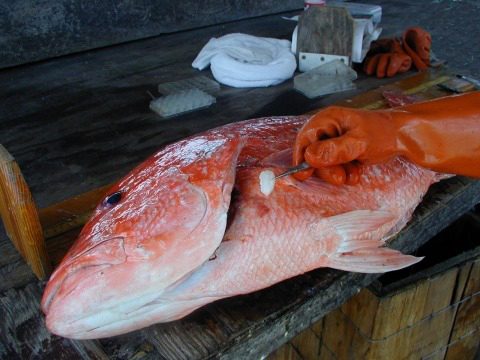Radiocarbon dating otoliths has the potential to confirm both the absolute age of individual fish and annuli formation. Despite the many techniques that can be used for age validation, only radiocarbon dating can provide the absolute age in a variety of fishes particularly the long-lived ones. The use of bomb-derived radiocarbon as a dated otolith marker is considered to be one of the most accurate and logistically feasible methods for the age validation of long-lived species. 1
Disclaimer: This video is hosted in a third-party site and may contain advertising.
Otoliths have growth rings similar to those observed in trees that can be used to estimate the age of the fish. There are two zones in otoliths indicating growth – a dark translucent zone representing a period of fast growth and a white opaque zone called annuli representing a period of slower growth. Annuli formation is likened to tree ring growth, both are used for age estimations.
Typically one ring is formed about every year. However, further studies (e.g. mark-recapture of chemically-tagged fish) are necessary to validate that one whole annulus is indeed equal to one year of growth. Combining this data with comparisons on the size of the fish sheds light on how fast the species grows.
These rings also contain a chemical makeup representative of the local environment the fish was in at the time of that particular growth ring. This chemical composition, including trace elements and isotopes, can be measured and used to track the movements of the fish throughout its lifetime.
Analysis of fish otoliths are included in various researches including those focused on mortality or population structure estimations and stock assessment models.

In fish, otoliths are hard carbonate structures sitting behind the brain that are involved in hearing and balance. There are three types of otoliths – the sagitta, asteriscus and lapillus. Not all fish have otoliths, and for those that do, the specific characteristics of the otoliths depend on the species.
Geochemical analyses of the otoliths can reveal a lot about the fish and its life including migration, its age and growth rate.
Beta Analytic accepts fish otoliths for radiocarbon dating with a recommended sample size of 5-20 mg. The lab uses Accelerator Mass Spectrometry (AMS) to analyze these samples. The minimum quantity for routine AMS analysis is 300 micrograms of carbon after pretreatment, though the lab can work with less upon discussion. The δ13C and δ18O measurements by isotope ratio mass spectrometry (IRMS) are included at no additional fee when submitting fish otolith samples for radiocarbon dating.
The pretreatment applied to samples directly affect the final result. You can contact the lab to discuss the pretreatment or request to be contacted once the pretreatment has been completed before the samples are analyzed in the accelerator mass spectrometer.
ISO 17025-accredited Beta Analytic reports radiocarbon dating results within 14 business days and fees include quality assurance reports, calendar calibration as applicable and access to both past results and pending analyses are available online 24/7. Please contact the lab for more information.
For fish otoliths and other carbonates, Beta Analytic also offers δ13C and δ18O stable isotope analysis not in conjunction with radiocarbon dating. The interpretation of stable isotope values lies with the submitter.
The Miami-based lab also provides these analyses:
– δ13C for cremated bones or organics
– δ13C and δ15N for non-cremated bones
– δ13C, δ18O and δD measurements for water
For samples that do not require lab pretreatment, stable isotope analysis results are reported in 7 business days. For samples that do require lab pretreatment, results are reported in 14 business days. Please contact the lab for sample sizes and prices.
References:
This entry was posted on Thursday, March 22nd, 2018 and is filed under Radiocarbon Dating .